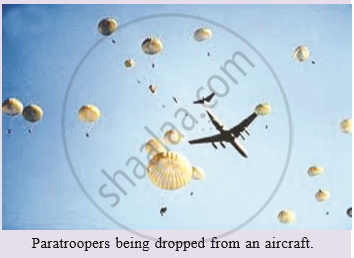Advertisements
Advertisements
Question
A hockey ball of mass 200 g travelling at 10 m s−1 is struck by a hockey stick so as to return it along its original path with a velocity at 5 m s−1. Calculate the change of momentum occurred in the motion of the hockey ball by the force applied by the hockey stick.
Solution
Mass of ball (m) = 200 g = 0.2 kg
Initial velocity of ball (u1) = 10 ms-1
∴ The initial momentum of the ball = mu1
= 0.2 kg × 10 ms-1
= 2 N s
Final velocity of ball (u2) = - 5 ms-1
(The minimum sign denotes that the ball is moving in the opposite direction.)
∴ Final momentum of ball = mu2
= 0.2 kg × (- 5 ms-1)
= - 1 N s
∴ Change in momentum = Final momentum - Initial momentum
= - 1Ns - 2Ns
= - 3Ns
The Minus sign denotes that the change in momentum is opposite to the direction of the initial momentum of the ball.
APPEARS IN
RELATED QUESTIONS
What is the change in momentum of a car weighing 1500 kg when its speed increases from 36 km/h to 72 km/h uniformly ?
Which physical quantity corresponds to the rate of change of momentum ?
Which physical principle is involved in the working of a jet aeroplane ?
A body of mass 2 kg is at rest. What should be the magnitude of force which will make the body move with a speed of 30 m/s at the end of 1 s ?
Explain why, a cricket player moves his hands backwards while catching a fast cricket ball.
State the law of conservation of momentum.
The troops (soldiers) equipped to be dropped by parachutes from an aircraft are called paratroopers. Why do paratroopers roll on landing ?
Suppose a ball of mass m is thrown vertically upward with an initial speed v, its speed decreases continuously till it becomes zero. Thereafter, the ball begins to fall downward and attains the speed v again before striking the ground. It implies that the magnitude of the initial and final momentums of the ball are the same. Yet, it is not an example of conservation of momentum. Explain why?
Two billiard balls A and B, each of mass 50 g and moving in opposite directions with speed of 5 ms–1 each, collide and rebound with the same speed. If the collision lasts for 10–3 s, which of the following statements are true?
- The impulse imparted to each ball is 0.25 kg ms–1 and the force on each ball is 250 N.
- The impulse imparted to each ball is 0.25 kg ms–1 and the force exerted on each ball is 25 × 10–5 N.
- The impulse imparted to each ball is 0.5 Ns.
- The impulse and the force on each ball are equal in magnitude and opposite in direction.
A 100 kg gun fires a ball of 1 kg horizontally from a cliff of height 500 m. It falls on the ground at a distance of 400 m from the bottom of the cliff. Find the recoil velocity of the gun. (acceleration due to gravity = 10 ms–2)
